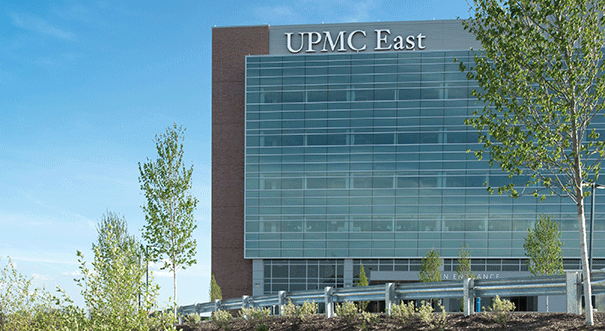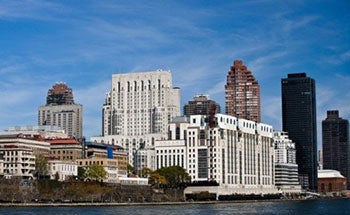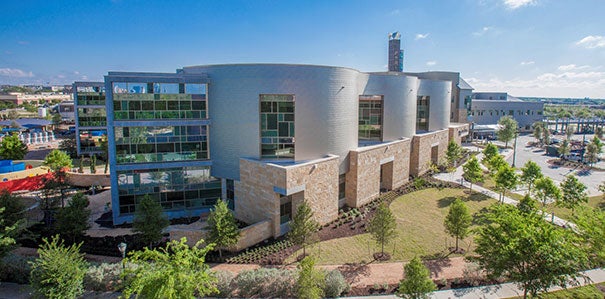Aligning sustainability with patient care
The energy to operate the buildings in which we work, shop, study and live costs the United States about $200 billion annually and, on average, 30 percent of this energy is wasted. Health care facilities are among the most energy-intensive of commercial buildings, costing more than $9 billion to operate each year. Some health care organizations, including the University of Pittsburgh Medical Center (UPMC), New York-Presbyterian Hospital and Ascension Health, have committed to energy-saving strategies and are sharing their solutions through the Department of Energy’s Better Buildings Challenge. By employing energy-efficiency strategies, they are lowering their costs, improving facility performance and reducing their carbon footprints.
These hospitals’ investments to make their operations more efficient align with their primary mission of excellent patient care. Each of these organizations is pursuing efficiency in different ways, but all are making significant progress as Better Buildings Challenge partners through ambitious portfolio-wide commitments.
University of Pittsburgh Medical Center: An all-inclusive view on energy efficiency. UPMC’s health care system portfolio contains 20 hospitals and more than 400 outpatient centers, totaling more than 13 million sq. ft. Drew Chidester, UPMC’s senior director of energy and environmental engineering initiatives, and his staff take a long-term, comprehensive view on energy-efficiency projects across the UPMC health system.
 |
| Photo courtesy of UPMC UPMC developed a holistic sustainability plan that integrates physician, staff and patient needs into its energy-saving solutions. |
“Holistically, we look at putting together an entire program, something that looks at physician needs, patient needs, as well as operating staff capabilities, and bring all that together as we move energy-efficiency projects forward,” he says.
From an operational perspective, UPMC tries to implement automated processes, which are easier for staff to maintain and produce greater environmental results. For example, motion sensors on lighting and automatic setbacks on HVAC systems ensure that equipment is automatically turned off when not in use, including in hallways and even operating rooms.
According to Chidester, “The name of the game in energy savings right now is sustainability. We are well beyond lighting and steam trap upgrades; that low-hanging fruit is yesterday’s news. Today, our staff have to strategically plan around long-term sustainability and conservation projects, many of which have us changing the way we manage daily operations.”
As a public entity, Chidester feels it’s important to be a good steward financially and environmentally. The reduction of UPMC’s operating cost through energy conservation results is a twofold benefit for the organization. “One is it reduces costs,” he explains. “But it also helps to keep the environment clean by reducing kWh or Btus that we’re consuming, ultimately providing lower costs.”
The medical center’s involvement in the Better Buildings Challenge has enabled it to engage better with staff on goals they all can contribute to, and “grow our energy-savings opportunities,” Chidester says.
New York-Presbyterian Hospital: Empowering employees to identify energy-savings opportunities. Based in New York City, New York-Presbyterian is one of the nation’s largest hospitals with some 2,600 beds. The hospital’s 6,000 affiliated physicians and 19,000 employees provide inpatient, ambulatory and preventive care in all areas of medicine. The hospital’s six campuses encompass 35 buildings and 10.5 million sq. ft., making it a top energy user in the New York metropolitan area.
To join the Better Buildings Challenge, the hospital needed to have a good understanding of its energy consumption, so benchmarking energy-usage data was key. From its work with the Challenge, the hospital was able to gain support from senior management to help implement and execute energy-conservation projects, including benchmarking and an employee engagement program.
 |
| Photo courtesty of New York-Presbyterian NYP kicked off its sustainability efforts by benchmarking its energy usage, giving it a better understanding of its energy consumption. |
The key to facilitywide savings is engaging employees and encouraging them to find ways to reduce energy, says Kathia Benitez, corporate energy program manager at the hospital.
Benitez and her staff developed the Gallery Walk Checklist as part of its Green Champions initiative.
It includes items that the team can check as they walk the hospital’s hallways, such as ensuring that computer monitors are turned off and noncritical equipment is unplugged when not in use. The team also identifies areas that would benefit from installation of occupancy motion sensors for lights.
“Our employees have all these wonderful ideas, but we need to formalize them somewhere,” Benitez says. “And that’s how the Better Buildings Challenge has really helped us.”
Employee recommendations gathered through the hospital’s Gallery Walk initiative are key to implementing energy-saving measures, including the installation of more than 300 motion sensors in areas with fluctuating occupancies. These efforts, in partnership with the hospital’s engineering staff, are key to driving down energy use.
Through their participation in the Better Buildings Challenge, partners also commit to sharing their strategies and successes so others can replicate them. “It’s always good to hear about what other peer hospitals are doing outside of New York-Presbyterian, just to leverage our program and improve what we're doing,” Benitez adds. “I'm constantly learning from other hospitals. It's a nice, friendly competition.”
Ascension Health: Setting ever-aggressive goals. Ascension Health employs more than 150,000 associates who provide health care services at nearly 1,900 locations nationwide. The company’s Environmental Stewardship Program seeks to improve the energy efficiency of its hospitals and health care facilities.
 |
| Photo courtesty of Ascension Ascension set an initial goal to reduce energy usage by 5 percent. It has since upgraded that goal to achieve a 20 percent reduction by 2020. |
Lois Sechrist is a sustainability senior analyst for Ascension’s Facilities Resource Group, which is responsible for design and construction, existing facilities improvement projects and portfolio-wide energy-management strategy.
Ascension’s facilities encompass a broad range of hospitals — large and small, new and old — as well as acute care facilities and critical access hospitals. The smaller, older facilities typically do not have the necessary infrastructure to implement building automation systems and other energy-saving measures, such as monitoring energy usage. Tracking energy was the first step on the path to helping the organization implement an energy program.
“When we started tracking energy use in 2008, we initially set a goal of reducing energy use by 5 percent across all of our facilities,” Sechrist says. Ascension accomplished that goal in June 2011, mostly by making behavioral changes and measuring and monitoring energy use to manage consumption better. “And once we met that goal, we said, ‘well, what should we do next? We need a bigger goal,’” she says.
Enter the Better Buildings Challenge. In 2011, Ascension set a goal to achieve a 20 percent reduction in energy usage (kBtu/sq. ft.) by 2020.
“It got us very focused,” says Sechrist. “And then it required that we come up with a game plan of exactly how we were going to accomplish our goals. So, we allowed our hospitals to work on their own for a couple of years to make improvements and changes.”
For its improvement projects, Ascension hired engineering firms to retrocommission all of its hospitals. The initiative was tremendously successful. In the third year of the four-year program, efficiency jumped from achieving 9.1 percent energy reduction in 2013 to 13.8 percent in 2014. “We went from $30 million in cost avoidance a year ago to $43 million cumulatively,” says Sechrist.
“If you don’t set a baseline and measure monthly, quarterly and yearly, you don’t know where you’re going or where you’ve been,” Sechrist says. “I absolutely stress the importance of tracking your usage and your cost.”
Transforming the health care industry
The goal of the Better Buildings Challenge is to make American commercial buildings, multifamily housing and industrial plants at least 20 percent more energy efficient in the next 10 years.
As Better Buildings Challenge partners, each of these hospital systems is helping to meet that goal via portfolio-wide implementation of innovative energy-saving solutions that also make good business sense. The more organizations share their results and lessons learned, the more the health care industry can transform knowledge into energy and cost savings.
The recently launched Better Buildings Challenge Solution Center helps organization to find a solution by topic, building type, solution type, building size, sector, technology, location and more. Users can explore more than 200 solutions tested and proven by partners, and learn how a variety of organizations finance their building solutions projects, implement emerging technologies, build their team’s energy expertise, motivate staff, get buy-in from management or establish communitywide initiatives.
Since 2011, 250 organizations have committed to improving their energy intensity by 20 percent in 10 years. Partners represent more than 3.5 billion sq. ft., 600 manufacturing facilities and $2 billion in financial investments.
Additional resources
- Read more about how UPMC created an energy management and engineering department with a targeted skill set and dedicated annual budget for energy-efficiency improvements.
- New York-Presbyterian Hospital launched a retrocommissioning program that blends energy management with improving the quality of patient care. Learn how it did it.
- Get more information on how Ascension Health established a dedicated annual budget for energy-efficiency upgrades and tracks progress annually.
Sara Schoen is the commercial real estate lead for the U.S. Department of Energy’s Better Buildings programs. Learn more at www.energy.gov/betterbuildingschallenge.




